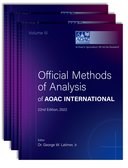 Official Methods of Analysis of AOAC INTERNATIONAL (22nd Edition)
Official Methods of Analysis of AOAC INTERNATIONAL (22nd Edition)
Contents
16.17.01
AOAC Official Method 984.29
Howard Mold CountingGeneral Instructions
Get access
-
Published:January 2023
Cite
Howard Mold CountingGeneral Instructions', in Dr. George W Latimer, Jr. (ed.), Official Methods of Analysis of AOAC INTERNATIONAL, 22nd Edition (
Extract
First Action 1984
See Figure 984.29A .
Diagnostic Characteristics of Mold
Before attempting to make mold count, analysts should be familiar with cellular structure of product. They can do this through direct microscopic examination of healthy tissue excised from raw product or through study of reference books. Analysts should assume that any product can be contaminated with a variety of vegetable, animal, and synthetic fibers. Presence of such materials greatly increases probability for misidentification of molds.
It is essential that analyst be able to distinguish hyphae and look-alikes with which they might be confused. Although many filaments can be easily and accurately recognized as mold, others require more careful appraisal before they can be reported as mold. Only rarely are all mold characteristics given here present at one time; usually 2 or 3 are absent. Features mentioned below are observed at 100–450×.
...
Determination
Clean Howard cell, 945.75B(m )(1) (see 16.1.01), so that Newton’s rings are produced between slide and cover glass. Remove cover and with knife blade or scalpel, place portion of well-mixed test sample on central disk; with same instrument, spread evenly over disk, and cover with glass so as to give uniform distribution. Use only enough test portion to bring material to edge of disk. (It is of utmost importance that portion be taken from thoroughly mixed test sample and spread evenly over slide disk. Otherwise, when cover slip is put in place, insoluble material, and consequently molds, may be more abundant at center of mount.) Discard any mount showing uneven distribution or absence of Newton’s rings, or liquid that has been drawn across moat and between cover glass and shoulder.
Sign in
Personal account
- Sign in with email/username & password
- Get email alerts
- Save searches
- Purchase content
- Activate your purchase/trial code
- Add your ORCID iD
Purchase
Our books are available by subscription or purchase to libraries and institutions.
Purchasing information| Month: | Total Views: |
|---|---|
| April 2024 | 7 |
| May 2024 | 3 |
| June 2024 | 6 |
| July 2024 | 7 |
| August 2024 | 9 |
| September 2024 | 4 |
| November 2024 | 6 |
| December 2024 | 7 |
| January 2025 | 5 |
| February 2025 | 15 |
| March 2025 | 7 |
| April 2025 | 4 |




Get help with access
Institutional access
Access to content on Oxford Academic is often provided through institutional subscriptions and purchases. If you are a member of an institution with an active account, you may be able to access content in one of the following ways:
IP based access
Typically, access is provided across an institutional network to a range of IP addresses. This authentication occurs automatically, and it is not possible to sign out of an IP authenticated account.
Sign in through your institution
Choose this option to get remote access when outside your institution. Shibboleth/Open Athens technology is used to provide single sign-on between your institution’s website and Oxford Academic.
If your institution is not listed or you cannot sign in to your institution’s website, please contact your librarian or administrator.
Sign in with a library card
Enter your library card number to sign in. If you cannot sign in, please contact your librarian.
Society Members
Society member access to a journal is achieved in one of the following ways:
Sign in through society site
Many societies offer single sign-on between the society website and Oxford Academic. If you see ‘Sign in through society site’ in the sign in pane within a journal:
If you do not have a society account or have forgotten your username or password, please contact your society.
Sign in using a personal account
Some societies use Oxford Academic personal accounts to provide access to their members. See below.
Personal account
A personal account can be used to get email alerts, save searches, purchase content, and activate subscriptions.
Some societies use Oxford Academic personal accounts to provide access to their members.
Viewing your signed in accounts
Click the account icon in the top right to:
Signed in but can't access content
Oxford Academic is home to a wide variety of products. The institutional subscription may not cover the content that you are trying to access. If you believe you should have access to that content, please contact your librarian.
Institutional account management
For librarians and administrators, your personal account also provides access to institutional account management. Here you will find options to view and activate subscriptions, manage institutional settings and access options, access usage statistics, and more.